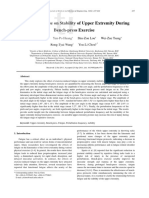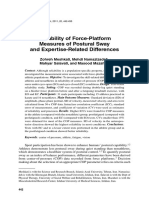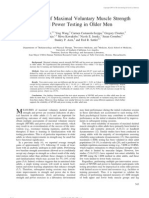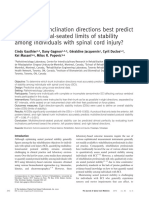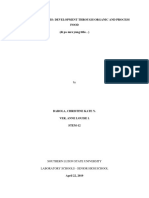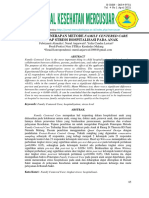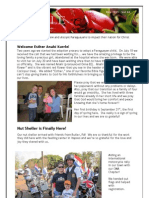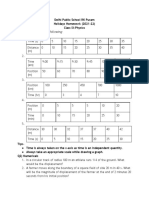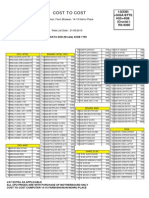5-Repetition Sit-To-Stand Test in Subjects With Chronic Stroke
5-Repetition Sit-To-Stand Test in Subjects With Chronic Stroke
Uploaded by
Dhieto Basuki PutraCopyright:
Available Formats
5-Repetition Sit-To-Stand Test in Subjects With Chronic Stroke
5-Repetition Sit-To-Stand Test in Subjects With Chronic Stroke
Uploaded by
Dhieto Basuki PutraCopyright
Available Formats
Share this document
Did you find this document useful?
Is this content inappropriate?
Copyright:
Available Formats
5-Repetition Sit-To-Stand Test in Subjects With Chronic Stroke
5-Repetition Sit-To-Stand Test in Subjects With Chronic Stroke
Uploaded by
Dhieto Basuki PutraCopyright:
Available Formats
407
ORIGINAL ARTICLE
5-Repetition Sit-to-Stand Test in Subjects With Chronic
Stroke: Reliability and Validity
Yiqin Mong, MSc, Tilda W. Teo, MSc, Shamay S. Ng, PhD
ABSTRACT. Mong Y, Teo TW, Ng SS. 5-repetition sit-tostand test in subjects with chronic stroke: reliability and validity. Arch Phys Med Rehabil 2010;91:407-13.
Objectives: To examine the (1) intrarater, interrater, and
test-retest reliability of the 5-repetition sit-to-stand test (5repetition STS test) scores, (2) correlation of 5-repetition STS
test scores with lower-limb muscle strength and balance performance, and (3) cut-off scores among the 3 groups of subjects: the young, the healthy elderly, and subjects with stroke.
Design: Cross-sectional study.
Setting: University-based rehabilitation center.
Participants: A convenience sample of 36 subjects: 12
subjects with chronic stroke, 12 healthy elderly subjects, and
12 young subjects.
Interventions: Not applicable.
Main Outcome Measures: 5-Repetition STS test time
scores; hand-held dynamometer measurements of hip flexors,
and knee flexors and extensors; ankle dorsiflexors and plantarflexors muscle strength; Berg Balance Scale (BBS); and limits
of stability (LOS) test using dynamic posturography.
Results: Excellent intrarater reliability of intraclass correlation coefficient (ICC) (range, .970 .976), interrater reliability
(ICC.999), and test-retest reliability (ICC range, .989 .999)
were found. Five-repetition STS test scores were also found to
be significantly associated with the muscle strength of affected
and unaffected knee flexors (.753 to .830; P.00556) of
the subjects with stroke. No significant associations were found
between 5-repetition STS test and BBS and LOS tests in
subjects with stroke. Cut-off scores of 12 seconds were found
to be discriminatory between healthy elderly and subjects with
stroke at a sensitivity of 83% and specificity of 75%.
Conclusions: The 5-repetition STS test is a reliable measurement tool that correlates with knee flexors muscle strength
but not balance ability in subjects with stroke.
Key Words: Muscle strength; Rehabilitation; Stroke.
2010 by the American Congress of Rehabilitation
Medicine
HE SIT-TO-STAND TEST was initially introduced as an
T
outcome measurement for functional lower limb muscle
strength. The 5-repetition STS test was first used as a physical
1
differentiate older adults (age range, 6390y) with and without
balance dysfunction.3 It was also used as an outcome measure
for evaluating effectiveness of intervention in subjects having
total hip and knee arthroplasty4 and vibration therapy5 and for
cross-sectional correlation studies in subjects with osteoarthritis6,7 and vestibular dysfunction.8 The 5-repetition STS test has
also been introduced as an outcome measure in studies investigating strength training and functional performance in subjects with chronic stroke,9,10 as well as cross-sectional studies
evaluating the association of disabilities and falls in population
with stroke.11,12 Despite the common use of the 5-repetition
STS test, test-retest reliability (ICC range, .890 .960) was
established in healthy older adults13,14 and elderly with osteoarthritis (ICC.960)7 but not in subjects with stroke.
Besides lower limb muscle strength, balance capacity of
subjects could also affect sit-to-stand performance.13,15 From a
sitting position, more horizontal momentum was required to
shift the posterior-located center of mass to rise to a standing
position,16 which demanded relatively good balance control.17
Stroke-specific lower limb muscle weakness18-20 and balance
impairments21-23 could lead to poor sitting to standing performance; however, the relationship between 5-repetition STS test
scores and balance performance was unclear.
The objectives of the present study were (1) to investigate the
intrarater, interrater, and test-retest reliability of the 5-repetition
STS test in subjects with chronic stroke; (2) to investigate the
relationship between the 5-repetition STS test and BBS, lower
limb muscle strength, and the measurements of LOS in subjects
with stroke; and (3) to determine the sensitivity of the 5-repetition
STS test in distinguishing differences in mobility among subjects
with stroke, healthy elderly, and young subjects.
METHODS
Participants
An ICC value of .957 for the 5-repetition STS test was
previously shown in healthy subjects14; thus, the ICC value for
subjects with stroke was hypothesized to be .930. Therefore, to
detect an ICC value of .930 at a significance level of .050 for
test-retest reliability, a sample size of 12 subjects was required
to achieve 93% power of 2 observations a subject.
performance measure to detect the associations with prediction
of mortality and disabilities in frail elderly2 as well as to
List of Abbreviations
From the Department of Physiotherapy, Tan Tock Seng Hospital (Mong), and
Inpatient Therapy Services, St Andrews Community Hospital (Teo), Singapore; and
the Department of Rehabilitation Sciences, Hong Kong Polytechnic University, Hong
Kong (SAR), China (Ng).
No commercial party having a direct financial interest in the results of the research
supporting this article has or will confer a benefit on the authors or on any organization with which the authors are associated.
Reprint requests to Shamay S. Ng, PhD, Department of Rehabilitation Sciences,
The Hong Kong Polytechnic University, Hung Hom, Kowloon, Hong Kong (SAR),
e-mail: shamay.ng@inet.polyu.edu.hk.
0003-9993/10/9103-00472$36.00/0
doi:10.1016/j.apmr.2009.10.030
AUC
BBS
COP
ICC
LOS
MVL
MXE
5-repetition STS test
RT
area under the receiver operating
characteristic curve
Berg Balance Scale
center of pressure
intraclass correlation coefficient
limits of stability
movement velocity
maximum excursion
5-repetition sit-to-stand test
reaction time
Arch Phys Med Rehabil Vol 91, March 2010
408
5-REPETITION SIT-TO-STAND TEST IN PATIENTS WITH STROKE, Mong
Convenience sampling was used to recruit 36 subjects, with 12
subjects in each of the 3 subjects groups: stroke, healthy elderly,
and young. Young subjects were recruited to determine the cut-off
score of the 5-repetition STS test. All subjects had to be able to
stand up independently from a chair without hand support.
Subjects with stroke were included if they were at least
1-year poststroke, were older than 50 years, were medically
stable, were able to ambulate more than 10m unassisted with or
without a walking aid, and had an Abbreviated Mental Test24
score of more than 7. Exclusion criteria were the presence of any
cerebellar involvement or other conditions that might affect muscle strength, balance, mobility status, or ability to follow instructions.
All subjects recruited in the healthy elderly and young
groups had to be more than 50 years of age or between 21 and
35 years old, respectively. Subjects having any conditions that
might affect the assessment protocol, such as uncontrolled
diabetes mellitus, were excluded from the study.
All subjects were required to sign written informed consent
forms before the commencement of the experimentation. Ethic
approval for this study was obtained from the ethics committee
of the local institution.
Outcome Measurements
5-repetition sit-to-stand test. The 5-repetition STS test
measured the time taken to complete 5 repetitions of the
sit-to-stand maneuver. All sit-to-stand maneuvers were performed from a chair without an arm rest at 43cm in height and
47.5cm in depth. All trials were videotaped with a videotaping
device. The first 2 trials were for familiarization purposes, and
the average of the next 3 trials was used for analysis. A
1-minute rest was given between trials to prevent fatigue.
Standardized instructions were given as follows: By the count
of 3, please stand up and sit down as quickly as possible for 5
times. Place your hands on your lap and do not use them
throughout the procedure. Lean your back against the chairs
backrest at the end of every repetition. The timing started once
the subjects back left the backrest and stopped once the back
touched the backrest.
Muscle strength of lower limb. Lower-limb muscle
strength was tested with a hand-held dynamometer. Good to
excellent reliability (ICC range, .840 .990)25,26 was reported
for lower-limb hand-held dynamometer strength measurements
in subjects with neurologic conditions. Isometric muscle strength
of hip flexors, knee flexors and extensors, and ankle plantarflexors and dorsiflexors were tested bilaterally with standardized
testing positions and dynamometer placement (table 1). Make
tests were performed on all muscle groups tested. Subjects
were secured on a high chair with safety belts to standardize the
assessment positions. The first 2 trials were for familiarization
purposes, and the mean reading of the last 3 trials were used for
analysis. One to 2 minutes of rest was given between trials to
prevent muscle fatigue. Subjects were instructed to Push
against my resistance as hard as you can.
Clinical balance performance: Berg Balance Scale. The
BBS was used to assess subjects ability to maintain stability.27
Excellent reliability of the BBS (ICC range, .980 .990)28,29
was found in patients with acute28 and chronic stroke.29 The
BBS involves 14 tasks; each has a score between 0 and 4,
adding up to a total score of 56.
Laboratory balance performance: limits of stability
test. LOS was assessed by dynamic posturography (Balance
Mastera), which measures the displacement of the COP during
voluntary movement in a designated direction without instability.30 A previous study demonstrated moderate reliability (ICC
range, .840 .880) in subjects with chronic stroke.29
Arch Phys Med Rehabil Vol 91, March 2010
Table 1: Muscle Strength Testing Position and Dynamometer
Placement
Muscle Group
Tested
Hip flexors
Knee flexors
Knee extensors
Ankle
dorsiflexors
Ankle
plantarflexors
Testing Position
Dynamometer Placement
High sitting
Hip: 90o flexion
Knee: 90o flexion
Ankle: neutral
High sitting
Hip: 90o flexion
Knee: 90o flexion
Ankle: neutral
High sitting
Hip: 90o flexion
Knee: 90o flexion
Ankle: neutral
High sitting
Hip: 90o flexion
Knee: full extension
Ankle: neutral
High sitting
Hip: 90o flexion
Knee: full extension
Ankle: neutral
On anterior aspect of
femur, 5cm proximal
to superior border of
patella
On posterior aspect of
tibia, 5cm proximal
from inferior tip of
medial malleoli
On anterior aspect of
tibia, 5cm proximal
from inferior tip of
medial malleoli
On ventral aspect of foot,
across 1st to 5th
metatarsophalangeal
joints
On dorsum aspect of foot,
across 1st to 5th
metatarsophalangeal
joints
Three parameters of LOS were measured:
1. RT, measured in seconds, refers to the time between the
appearance of the signal for movement and the initiation
of the first movement.30
2. MVL, measured in degrees a second, is defined as the
average speed of COP displacement during the first
movement toward the given target.30
3. MXE, expressed as the percentage of the target distance
being tested, refers to the maximal displacement of COP
during the entire LOS testing for each target.30
Subjects were instructed to Begin each trial with the cursor
in the middle box. On hearing a Ding, move the cursors as
fast and as accurately as possible into the box where the circle
appeared. Shift your body weight to control the position and
direction of the cursors. Maintain your balance and keep your
feet firmly on the platform throughout the assessment.
Procedures
Five trials of the 5-repetition STS test were measured simultaneously by the 2 examiners with 3 years of clinical experience. These trials were videotaped and shown to 3 physiotherapists with 3 to 7 years of clinical experience and 3 tertiary
students without a medical or health care background. Procedures for data collection of intrarater, interrater, and test-retest
reliability are illustrated in figure 1. The BBS, muscle strength,
and dynamic posturography measurements of LOS were tested
in random order by either examiner A or examiner B.
Statistical Analysis
Data analysis was done with SPSS version 17.0.b The Kolmogorov-Smirnov test and F test were used to assess the
normal distribution and equal variance of the test score. Descriptive statistics were used for sociodemographic characteristics evaluation. Differences between the mean test score
across the 3 groups were calculated by 1-way analysis of
variance. ICC was used to calculate the degree of intrarater
(ICC3,1), interrater (ICC3,2), and test-retest reliability (ICC2,1).
The relationship between the 5-repetition STS test score and
5-REPETITION SIT-TO-STAND TEST IN PATIENTS WITH STROKE, Mong
409
Fig 1. Procedure of data collection.
the muscle strength of affected and unaffected limbs and balance performance in subjects with stroke was established by
the Spearman correlation coefficient because the data were not
normally distributed. When multiple correlation tests were
performed, the Bonferroni adjustment was applied to adjust for
the alpha level.31 In order to assess the correlation between the
5-repetition STS test and 9 primary outcomes (affected and
unaffected knee extensors strength, affected and unaffected
knee flexors strength, affected and unaffected ankle dorsiflexors, BBS, and maximal excursion in forward and backward
direction of LOS), the P value after Bonferroni correction is
.05/9 (ie, .00556). The strength of the correlation was defined
by the correlation coefficient obtained as little or no (.250),
fair (.250 .500), moderate to good (.500 .750), or good
to excellent (.750) relationship.31 A significance level of
.050 was set for all analyses.
Sensitivity indicates the true-positive probability, whereas
specificity indicates the false-positive probability.31 A trade-off
between sensitivity and 1 minus specificity was performed
using the Youden index32 to obtain the most appropriate 5-repetition STS test cut-off score. The AUC then provides a quantitative measure of the accuracy of the test based on the null
hypothesis of AUC equal to 0.5.31
RESULTS
Descriptive statistics of all subjects and mean values of all
outcome measures are presented in tables 2 and 3, respectively.
Excellent intrarater reliability (ICC.970 .976) (table 4), interrater reliability (ICC.999), and test-retest reliability of
experienced physiotherapists (ICC1.000) and students
(ICC.994) were achieved in the present study.
Table 5 demonstrates the Spearman correlation analyses
of 5-repetition STS test scores in lower limb muscle
strength, BBS, and LOS. Five-repetition STS test scores had
significant negative correlation after Bonferroni correction
with affected (.753; P.005) and unaffected (.830;
P.001) knee flexors of subjects with stroke. No significant
associations were found between 5-repetition STS test score
with BBS and LOS performance in subjects with stroke.
Five-repetition STS test cut-off scores of 9.4 seconds and
12.2 seconds were found to be the best discriminators between
our young versus healthy elderly (sensitivity75%; specificity75%) and healthy elderly versus subjects with stroke (sensitivity83%; specificity75%), respectively. AUC analysis is
shown in figures 2a and 2b.
DISCUSSION
Reliability of the 5-Repetition Sit-to-Stand Test
This is the first study to investigate the intrarater, interrater,
and test-retest reliability of the 5-repetition STS test in people
with chronic stroke. A better reliability range of the 5-repetition STS test was noted in subjects with stroke (ICC range,
.971.999) than those previously reported in community-dwellArch Phys Med Rehabil Vol 91, March 2010
410
5-REPETITION SIT-TO-STAND TEST IN PATIENTS WITH STROKE, Mong
Table 2: Mean Values of Demographics and 5-Repetition Sit-to-Stand Test in 3 Subject Groups
Mean Values
Parameters
Young (n12)
Healthy Elderly
(n12)
Demographics
Age (y)
Sex (M/F)
Height (cm)
Weight (kg)
Body mass index (kg/m2)
5-repetition STS test (s)
26.22.9
9/3
160.85.5
57.511.0
22.13.4
8.90.7
56.03.7
10/3
155.36.0
57.911.5
23.93.8
10.81.7
P (Post Hoc Comparisons)
Stroke (n12)
60.04.8
6/6
157.612.7
61.612.1
24.62.0
17.17.5
.001*
.194
.311
.628
.160
.001*
Young vs
Stroke
Healthy Elderly
vs Stroke
.001
.001*
.013
NA
NA
NA
NA
.004*
Young vs Healthy
Elderly
.001
.569
NOTE. Values are mean SD.
Abbreviations: F, female; M, male; NA, not applicable.
*Denotes significant difference at P.05.
Denotes significant difference at P.05 using Tukey Honestly Significant Difference adjustment.
ing elderly (ICC range, .640 .960)13,14,33-35 and frail elderly
(ICC.670).36 Unlike in other studies,13,14,33-36 the experienced and inexperienced assessors were shown video clips of
the test on both occasions, and this could have contributed to
better reliability by minimizing participant-related factors on
the performance of the 5-repetition STS test. The well defined
assessment protocol with standardized use of instructions14 and
equipment reduced variations in measurements, which could
have contributed to the excellent reliability in this study.
This was the pioneering study to determine the effect of
assessors training background on the reliability of the 5-repetition STS test. The results strongly indicated that reliability
can be preserved regardless of the assessors training background. This could promote the use of the 5-repetition STS test
in clinical settings with patients with stroke. The influence of
assessors on the reliability of the 5-repetition STS test was
formerly reported to be minimal, because assessors were found
to contribute .028% to .030% of the estimated source of the
variance component.33
Performance of 5-Repetition Sit-to-Stand Test in Subjects
With Stroke
The mean 5-repetition STS test scores of the subjects with
stroke (17.17.5s) were comparable to timing achieved by
participants (17.97.7s) of a similar age group (approximately
60y)11 but superior to the score (time range, 19.323.6s) reported in an older age group (65.8 70y).9,10,12 It was noted that
the elderly clocked a longer duration for the 5-repetition STS
test with increased age.14 Consistent with a previous study,37
the subjects with stroke had a longer sit-to-stand duration
because of stroke-specific impairments such as lower-limb
muscle weakness38,39 and poor balance.37 Poststroke muscle
weakness caused by the failure in motor unit recruitment and a
decrease in firing frequency40 as well as localized adaption of
paretic muscle fiber41 could impede sit-to-stand performance.
Correlations of 5-Repetition Sit-to-Stand Test Scores
With Other Outcome Measures
Relationship of 5-repetition sit-to-stand test with muscle
strength. It is interesting to note the significant correlation
between 5-repetition STS test scores and bilateral knee flexors
strength (affected .753; unaffected .830) in this study.
Although previous investigations on the correlation between
knee flexors strength and sit-to-stand performance were absent,
knee flexors were known to maintain knee joint stability and
assist in extending hip joints during sit-to-stand performance.38
It is reasonable to observe an involvement of knee flexors in
providing more stability to the knee joint and higher extension
force in the hip joint during a fast-paced 5-repetition STS test.
In contrast with other studies,9,39 a lack of significant correlations was noted between 5-repetition STS test scores and the
other muscle groups (see table 5). Five-repetition STS test
scores were previously reported to have significant negative
correlations with affected hip flexor,9 affected knee extensor,39
Table 3: Mean Values of All Outcome Measures in Subjects With Stroke (n12)
Mean Values
Parameters
Muscle strength (kg)
Hip flexors
Knee flexors
Knee extensors
Ankle dorsiflexors
Ankle plantarflexors
Balance assessments
BBS
LOS
Reaction time (s)
Movement velocity (/s)
Maximal excursion (%)
NOTE. Values are mean SD.
Abbreviation: NA, not applicable.
Arch Phys Med Rehabil Vol 91, March 2010
Affected
13.94.5
6.83.7
14.84.7
6.14.1
13.05.4
Unaffected
Forward
19.04.7
14.53.6
21.75.8
12.83.7
21.76.6
Backward
NA
49.17.1
0.90.4
2.81.3
60.322.1
1.00.4
4.22.3
70.323.1
1.10.5
2.81.5
55.917.9
0.70.5
1.61.1
35.617.3
5-REPETITION SIT-TO-STAND TEST IN PATIENTS WITH STROKE, Mong
411
Table 4: Intrarater Reliability of 5-Repetition STS Test Scores in
Subjects With Stroke
Assessor
Mean 5-Repetition
STS test score (s)
ICC(3,1) (95% CI)
17.17.5
16.97.6
.975 (.935.992)
.976 (.937.992)
16.97.6
16.77.6
17.07.5
.976 (.939.992)
.971 (.925.991)
.974 (.932.992)
16.97.6
16.87.5
16.87.5
.970 (.932.990)
.970 (.924.991)
.972 (.929.991)
Examiner
A
B
Experienced
C
D
E
Inexperienced
F
G
H
NOTE. Values are mean SD.
Abbreviation: CI, confidence interval.
and affected ankle dorsiflexor muscle strength.39 According to
the graph, which showed the changes of significant values of
correlation coefficients in function of sample size for 1 to 100
correlations,42 the correlation between affected knee extensor
(.687) and unaffected ankle dorsiflexor (.629) would
approach significant if the sample size were increased to 20
subjects. Besides the small sample recruited, the discrepancy
between our findings and other studies may be a result of the
differences in the methods used to quantify muscle strength,
the testing positions (gravity-assisted or gravity-eliminated positions) adopted during muscle testing, and the characteristics
of the subjects with stroke.
Relationship of 5-repetition sit-to-stand test with balance
measures. No significant correlations were found between
5-repetition STS test scores and BBS in the subjects with stroke
in this study. The BBS was a valid measure of standing balance
in people with stroke,43 and the lower-limb muscle strength as
measured by the 5-repetition STS test was found to contribute
43% of a total variance in BBS in patients with chronic
stroke.11 The small sample size recruited might have resulted in
the lack of significant correlation between the 5-repetition STS
test and BBS. Another possible explanation is the difference
in the measurement domains of both tests. While the BBS
grades the quality of balance performance, the 5-repetition STS
test measures solely the speed (ie, time scores) at which sit-toTable 5: Spearman Correlation Coefficient Between 5-Repetition
STS Test and Muscle Strength, BBS and LOS in Subjects With
Stroke
Parameters
Muscle strength (kg)
Hip flexors
Knee flexors
Knee extensors
Ankle dorsiflexors
Ankle plantarflexors
BBS
LOS
Reaction time (s)
Movement velocity (/s)
Maximal excursion (%)
Affected
Unaffected
Forward
.587
.753*
.687
.007
.406
.336
.830*
.483
.629
.510
.551
.210
.147
.084
.210
.147
.084
Backward
NA
NA
NA
NA
NA
.531
.480
.578
Fig 2. ROC curves for 5-repetition STS test scores between (A)
young versus healthy elderly (AUC.816) and (B) healthy elderly
versus stroke (AUC.840). The curved line indicates ROC curve. The
straight line indicates nondiscriminating characteristics of the test.
Abbreviation: ROC, receiver operating characteristic.
.255
.179
.267
Abbreviation: NA, not applicable.
*Significant difference after Bonferroni correction at P.05/
9 (P.00556).
stand maneuvers are performed. In addition, the BBS is known
for its ceiling effects,44,45 which may account for the lack of
correlation with the 5-repetition STS test.
It is surprising to note that no significant correlations were
found between the 5-repetition STS test and LOS MXE in the
Arch Phys Med Rehabil Vol 91, March 2010
412
5-REPETITION SIT-TO-STAND TEST IN PATIENTS WITH STROKE, Mong
forward direction in subjects with stroke. In the transition
phase of sitting to standing, the initiation of accelerating
horizontal momentum occurred, followed by vertical decelerating momentum.46 This motion allowed erect standing to take
place from a sitting position. In LOS testing, horizontal movements of the subjects with stroke were examined in terms of
their RT, MVL, and MXE. During fast-paced sit-to-stand
movement, increased generation of forward momentum16,39
and anteroposterior sway were demonstrated in subjects with
stroke.37 The LOS required subjects to possess acceptable
visual perceptual capabilities, with a sufficient amount of concentration and attention to track the cursor and move their
center of mass toward the designated direction.44 However, the
5-repetition STS test was considerably less challenging because subjects did not need to rely heavily on visual cues or
extra concentration to perform the task correctly. The small
sample size recruited in this study might also have contributed
to the lack of correlation found between the 5-repetition STS
test and LOS.
Sensitivity of 5-Repetition Sit-to-Stand Test Scores
This was the first study to investigate cut-off scores among
the young, healthy elderly, and subjects with stroke. We found
that our 5-repetition STS test scores were sensitive at discriminating subjects from the 3 groups of the young, healthy elderly, and subjects with stroke with AUC of more than 80%.
Moreover, we found a cut-off score of 9.4 seconds between the
young and healthy elderly. This is similar to the cut-off score
of 10 seconds reported in subjects younger than 60 years.3 It is
also interesting to find that the difference between the cut-off
scores between the 2 groups (young vs healthy elderly and
healthy elderly vs stroke) is only 3 seconds. This might be
attributed to the high functional status of our chronic stroke
sample.
Study Limitations
The 5-repetition STS test could assess functional lower-limb
muscle strength but could not differentiate specific weakness in
each lower limb. The quality of performing the sit-to-stand task
might be overlooked because speed is the main focus of the
5-repetition STS test. Our study has several limitations. First,
the height of the chair used may not be optimal for all subjects
because of variations in the subjects leg lengths. Second,
factors such as weight-bearing asymmetry47 and foot placement48 were known to influence sit-to-stand performance but
were not measured in the present study. Third, our results
cannot be generalized to other disease-specific populations
because of our subjects selection criteria. Fourth, because
some of the muscle groups were not tested in gravity-eliminated positions, the effect of gravity might have affected the
muscle strength reading obtained. Fifth, our sample size estimation was based on the test-retest reliability of the 5-repetition STS test, which might be not sufficient to detect significant
correlation among 5-repetition STS test scores, muscle strength,
and balance ability.42 In addition, our study could not establish
any causal relationship between variables because of its crosssectional design. Future investigations with larger sample sizes
will be essential for prediction and regression analysis as well as
establishing the validity of the 5-repetition STS test in subjects
with stroke of different mobility levels.
CONCLUSIONS
The 5-repetition STS test is an easy-to-administer clinical
tool, suitable for both experienced and nonexperienced clinicians, with excellent intrarater, interrater, and test-retest reliArch Phys Med Rehabil Vol 91, March 2010
ability. Significant negative correlations with lower-limb muscle strength indicated that the 5-repetition STS test could be
used as a functional muscle strength assessment tool in people
with stroke.
Acknowledgment:
statistical advice.
We thank Dr. Raymond C.K. Chung for his
References
1. Csuka M, McCarty DJ. Simple method for measurement of lower
extremity muscle strength. Am J Med 1985;78:77-81.
2. Guralnik JM, Simonsick EM, Ferrucci L, et al. A short physical
performance battery assessing lower extremity function: association with self-reported disability and prediction of mortality and
nursing home admission. J Geron Med Sci 1994;49:M85-94.
3. Whitney SL, Wrisley DM, Marchetti GF, et al. Clinical measurement of sit-to-stand performance in people with balance disorders:
validity of data for the Five-Times-Sit-to-Stand Test. Phys Ther
2005;85:1034-45.
4. De Groot IB, Bussmann HJ, Stam HJ, Verhaar JA. Small increase
of actual physical activity 6 months after total hip or knee arthroplasty. Clin Orthop Relat Res 2008;466:2201-8.
5. Runge M, Rehfeld G, Resnicek E. Balance training and exercise in
geriatric patients. J Musculoskel Neuron Interact 2000;1:61-5.
6. Howe T, Oldham J. Functional tests in elderly osteoarthritic
subjects: variability of performance. Nurs Stand 1995;9:35-8.
7. Lin YC, Davey RC, Cochrane T. Tests for physical function of the
elderly with knee and hip osteoarthritis. Scand J Med Sci Sports
2001;11:280-6.
8. Whitney SL, Wrisley DM, Brown KE, Furman JM. Is perception
of handicap related to functional performance in persons with
vestibular dysfunction? Otol Neurotol 2004;25:139-43.
9. Weiss A, Suzuki T, Bean J, Fielding R. High intensity strength
training improves strength and functional performance after
stroke. Am J Phys Med Rehabil 2000;79:369-76.
10. Ouellette MM, LeBrasseur NK, Bean JF, et al. High-intensity
resistance training improves muscle strength, self-reported function, and disability in long-term stroke survivors. Stroke 2004;35:
1404-9.
11. Belgen B, Beninato M, Sullivan PE, Narielwalla K. The association of balance capacity and falls self-efficacy with history of
falling in community-dwelling people with chronic stroke. Arch
Phys Med Rehabil 2006;87:554-61.
12. LeBrasseur NK, Sayers SP, Ouellette MM, Fielding RA. Muscle
impairments and behavioural factors mediate functional limitations and disability following stroke. Phys Ther 2006;86:1342-50.
13. Lord SR, Murray SM, Chapman K, Munro B, Tiedemann A.
Sit-to-stand performance depends on sensation, speed, balance,
and psychological status in addition to strength in older people. J
Geron Med Sci 2002;57:M539-43.
14. Bohannon RW, Shove ME, Barreca SR, Masters LM, Sigounin
CS. Five-repetition sit-to-stand test performance by communitydwelling adults: a preliminary investigation of times, determinants
and relationship with self-reported physical performance. Isokinet
Exerc Sci 2007;15:77-81.
15. McCarthy EK, Horvat MA, Holtsberg PA, Wisenbajer JM. Repeated chair stands as a measure of lower limb strength in sexagenarian women. J Geron Med Sci 2004;59:1207-12.
16. Pai YC, Rogers MW. Control of body mass transfer as a function
of speed of ascent in sit-to-stand. Med Sci Sports Exerc 1990;22:
378-84.
17. Gross MM, Stevenson PJ, Charette SL, Pyka G, Marcus R. Effect
of muscle strength and movement speed on the biomechanics of
rising from a chair in healthy elderly and young women. Gait
Posture 1998;8:175-85.
5-REPETITION SIT-TO-STAND TEST IN PATIENTS WITH STROKE, Mong
18. Bernardi M, Rosponi A, Castellano V, et al. Determinants of
sit-to-stand capability in the motor impaired elderly. J Electro
Kines 2004;14:401-10.
19. Pattern C, Lexell J, Brown HE. Weakness and strength training in
persons with poststroke hemiplegia: rationale, method and efficacy. J Rehabil Res Dev 2004;41:293-312.
20. Newham DJ, Hsiao SF. Knee muscle isometric strength, voluntary
activation and antagonist co-contraction in the first six months
after stroke. Disabil Rehabil 2001;23:379-86.
21. Tyson SF, Hanley M, Chillala J, Selley A, Tallis RC. Balance
disability after stroke. Phys Ther 2006;86:30-8.
22. Geurts AC, Haart M, van Nes JW, Duysens J. A review of standing
balance recovery from stroke. Gait Posture 2005;22:267-81.
23. Niam S, Cheung W, Sullivan PE, Kent S, Gu X. Balance and
physical impairments after stroke. Arch Phys Med Rehabil 1999;
80:1227-33.
24. Hodkinson HM. Evaluation of a mental test score for assessment
of mental impairment in the elderly. Age Ageing 1972;1:233-8.
25. Bohannon RW, Andrews AW. Interrater reliability of hand-held
dynamometry. Phys Ther 1987;67:931-3.
26. Bohannon RW. Test-retest reliability of hand-held dynamometry
during a single session of strength assessment. Phys Ther 1986;
66:206-9.
27. Berg K, Wood-Dauphinee S, Williams JI, Gayton D. Measuring
balance in the elderly: preliminary development of an instrument.
Physiother Can 1989;41:304-11.
28. Berg K, Wood-Dauphinee S, Williams JI. The Balance Scale:
reliability assessment with elderly residents and patients with an
acute stroke. Scand J Rehabil Med 1995;27:27-36.
29. Liston RA, Brouwer BJ. Reliability and validity of measures
obtained from stroke patients using the Balance Master. Arch
Phys Med Rehabil 1996;77:425-30.
30. NeuroCom International, Inc. Limit of stability (LOS). 2009.
Available at: http://ncmseminars.com/neurocom/protocols/
motorimpairment/los.aspx. Accessed June 1, 2009.
31. Portney LG, Watkins MP. Foundations of clinical research: applications to practice. 3rd ed. Upper Saddle River: Prentice Hall;
2007.
32. Le CT. A solution for the most basic optimization problem associated
with an ROC curve. Stats Methods Med Res 2006;15:571-84.
33. Ostchega Y, Harris TB, Hirsch R, Parsons VL, Kington R, Katzoff
M. Reliability and prevalence of physical performance examination assessing mobility and balance in older persons in the US:
data from the Third National Health and Nutrition Examination
Survey. J Am Geriatr Soc 2000;48:1136-41.
34. Schaubert K, Bohannon RW. Reliability of the sit-to-stand test
over dispersed test sessions. Isokine Exerc Sci 2005;13:119-22.
413
35. Schaubert K, Bohannon RW. Reliability and validity of three
strength measures obtained from community-dwelling elderly persons. J Strength Cond Res 2005;19:717-20.
36. Jette AM, Jette DU, Ng J, Plotkin DJ, Bach MA, The Musculoskeletal Impairment (MSI) Study Group. Are performance-based
measures sufficiently reliable for use in multicenter trials? J Gerontol A Biol Sci Med Sci 1999;54:M3-6.
37. Chou SW, Wong AM, Leong CP, et al. Postural control during
sit-to-stand and gait in stroke patients. Am J Phys Med Rehabil
2003;82:42-7.
38. Cheng PT, Chen CL, Wang CM, Hong WH. Leg muscle activation patterns of sit-to-stand movement in stroke patients. Am J
Phys Med Rehabil 2004;83:10-6.
39. Lomaglio MJ, Eng JJ. Muscle strength and weight-bearing symmetry relate to sit-to-stand performance in individuals with stroke.
Gait Posture 2005;22:126-31.
40. Gemperline JJ, Allen S, Walk D, Rymer WZ. Characteristics of
motor unit discharge in subjects with hemiparesis. Muscle Nerve
1995;18:1101-14.
41. Horstman AM, Beltman MJ, Gerrits KH, et al. Intrinsic muscle
strength and voluntary activation of both lower limb and functional performance after stroke. Clin Physiol Funct Imaging 2008;
28:251-61.
42. Curtin F, Schulz P. Multiple correlations and Bonferronis correlation. Biol Psychiatry 1998;44:775-7.
43. Stevenson TJ. Detecting change in patients with stroke using the
Berg balance scale. Aus J Phys 2001;47:29-38.
44. Newstead AH, Hinman MR, Tomberlin JA. Reliability of Berg
Balance Scale and Balance Master limits of stability tests for
individuals with brain injury. J Neurol Phys Ther 2005;29:18-23.
45. Blum L, Bitensky NK. Usefulness of the Berg balance scale in stroke
rehabilitation: a systematic review. Phys Ther 2008;88:559-66.
46. Mourey F, Grishin A, dAthis P, Pozzo T, Stapley P. Standing up
from a chair as a dynamic equilibrium task: a comparison between
young and elderly subjects. J Gerontol 2000;55:B425-31.
47. Britton E, Harris N, Turton A. An exploratory randomized controlled trial of assisted practice for improving sit-to-stand in stroke
patients in the hospital setting. Clin Rehabil 2008;22:458-68.
48. Lecours J, Nadeau S, Gravel D. Interaction between foot placement, truck frontal position, weight-bearing and knee moment
asymmetry at seat-off during rising from a chair in healthy
controls and persons with hemiparesis. J Rehabil Med 2007;
40:200-7.
Suppliers
a. NeuroCom International, Inc, 9570 SE Lawnfield Rd, Clackamas,
OR 97015.
b. SPSS Inc, 233 S Wacker Dr, 11th Fl, Chicago, IL 60606.
Arch Phys Med Rehabil Vol 91, March 2010
You might also like
- Effects of Fatigue On Stability of Upper Extremity During Bench-Press ExerciseDocument5 pagesEffects of Fatigue On Stability of Upper Extremity During Bench-Press Exerciseyp huangNo ratings yet
- Oblicon Samplex AnswersDocument11 pagesOblicon Samplex AnswersEnvy Lace75% (4)
- Types of CurriculumDocument15 pagesTypes of CurriculumReanu Mithra67% (3)
- Bunkie Test - 2015Document10 pagesBunkie Test - 2015antoniovictorsouzacavalcanteNo ratings yet
- Bru Mitt Rehabil Res Pract 2015Document11 pagesBru Mitt Rehabil Res Pract 2015Mskola KarlovacNo ratings yet
- Bohannon2010 Performance PDFDocument6 pagesBohannon2010 Performance PDFmariasol63No ratings yet
- Evaluating Abdominal Core Muscle Fatigue: Assessment of The Validity and Reliability of The Prone Bridging TestDocument9 pagesEvaluating Abdominal Core Muscle Fatigue: Assessment of The Validity and Reliability of The Prone Bridging TestOMAR ANDRES OSORIO GARCIANo ratings yet
- Orthopaedic JournalDocument6 pagesOrthopaedic JournalZiad AlazthaNo ratings yet
- Ankle Dorsiflexion, Not Plantarflexion Strength, Predicts The Functional Mobility of People With Spastic HemiplegiaDocument5 pagesAnkle Dorsiflexion, Not Plantarflexion Strength, Predicts The Functional Mobility of People With Spastic HemiplegiaDavid SugiartoNo ratings yet
- Elboim-Gabyzon Et Al (2012)Document4 pagesElboim-Gabyzon Et Al (2012)Mateja BrebenNo ratings yet
- Reliability of Gait Performance Tests in Men and Women With Hemiparesis After StrokeDocument8 pagesReliability of Gait Performance Tests in Men and Women With Hemiparesis After StrokeKaniNo ratings yet
- 05meshkati JSR 20090094 CeDocument15 pages05meshkati JSR 20090094 Cericcardo6grassiNo ratings yet
- Jpts 27 2621Document4 pagesJpts 27 2621vvNo ratings yet
- Art 6antcdntes InglesDocument6 pagesArt 6antcdntes InglesNat LesNo ratings yet
- Hes Sari 2012Document6 pagesHes Sari 2012bbvnrsh279No ratings yet
- 1804 13 7972 3 10 20180717Document13 pages1804 13 7972 3 10 20180717ammar hussain darNo ratings yet
- Ito Test: Does Height of The Pad Affect Back Muscle Endurance?Document7 pagesIto Test: Does Height of The Pad Affect Back Muscle Endurance?Dr. Krishna N. SharmaNo ratings yet
- Citokinas y Adulto MayorDocument7 pagesCitokinas y Adulto MayorReynaldo TrianaNo ratings yet
- 2007 Schroeder ReliabilityDocument7 pages2007 Schroeder ReliabilityChris SzedlakNo ratings yet
- J Physio 2017 03 002Document27 pagesJ Physio 2017 03 002sina dabiriNo ratings yet
- Ercan 2017Document6 pagesErcan 2017Alvian YapantoNo ratings yet
- Aductor TestDocument8 pagesAductor TestCarles PeiroNo ratings yet
- Resistance Ex Bone TurnoverDocument7 pagesResistance Ex Bone TurnoverHari25885No ratings yet
- A Study of The Clinical Test of Sensory Interaction and Balance.Document6 pagesA Study of The Clinical Test of Sensory Interaction and Balance.Olivia XuNo ratings yet
- Effect of Jumping Exercise On Muscle Strength and Balance of Elderly People: A Randomized Controlled TrialDocument4 pagesEffect of Jumping Exercise On Muscle Strength and Balance of Elderly People: A Randomized Controlled TrialAntonia SanchezNo ratings yet
- Effect of Submaximal Contraction Intensity in Contract-Relax Proprioceptive Neuromuscular Facilitation StretchingDocument2 pagesEffect of Submaximal Contraction Intensity in Contract-Relax Proprioceptive Neuromuscular Facilitation StretchingI Made Dhita PriantharaNo ratings yet
- A Single-Blind, Cross-Over Trial of Hip Abductor Strength Training To Improve Timed Up Go Performance in Patients With Unilateral, Transfemoral AmputationDocument7 pagesA Single-Blind, Cross-Over Trial of Hip Abductor Strength Training To Improve Timed Up Go Performance in Patients With Unilateral, Transfemoral AmputationJhony GonzalezNo ratings yet
- Between-Session Reliability of Four Hop Tests and The Agility T-TestDocument8 pagesBetween-Session Reliability of Four Hop Tests and The Agility T-TestsebastixmasterNo ratings yet
- Ijspt 15 203Document7 pagesIjspt 15 203ceydaalyazhotamisNo ratings yet
- Effect of Isometric Quadriceps Exercise On Muscle Strength, Pain, and Function in Patients With Knee Osteoarthritis: A Randomized Controlled StudyDocument4 pagesEffect of Isometric Quadriceps Exercise On Muscle Strength, Pain, and Function in Patients With Knee Osteoarthritis: A Randomized Controlled StudyHusnannisa ArifNo ratings yet
- Chair Stand Tests: Purpose/population For Which Tool Was DevelopedDocument35 pagesChair Stand Tests: Purpose/population For Which Tool Was DevelopedswayamNo ratings yet
- Propiocepcion Hombro Post CirugiaDocument6 pagesPropiocepcion Hombro Post Cirugiamarcelogascon.oNo ratings yet
- Ijerph 16 03509Document11 pagesIjerph 16 03509Chloe BujuoirNo ratings yet
- Which Trunk Inclination Directions Best Predict Multidirectional-Seated Limits of Stability Among Individuals With Spinal Cord Injury?Document8 pagesWhich Trunk Inclination Directions Best Predict Multidirectional-Seated Limits of Stability Among Individuals With Spinal Cord Injury?Chanapass DenduangNo ratings yet
- Pzac 056Document9 pagesPzac 056ganesh goreNo ratings yet
- Reliability and Validity of The Modified Sphygmomanometer Test For The Assessment of Strength of Upper Limb Muscles After StrokeDocument9 pagesReliability and Validity of The Modified Sphygmomanometer Test For The Assessment of Strength of Upper Limb Muscles After Strokechocolate cupcakeNo ratings yet
- Gregory F. Marchetti, Jennica Bellanca, Susan L. Whitney, James Chia-Cheng Lin, Mark C. Musolino, Gabriel R. Furman and Mark S. RedfernDocument9 pagesGregory F. Marchetti, Jennica Bellanca, Susan L. Whitney, James Chia-Cheng Lin, Mark C. Musolino, Gabriel R. Furman and Mark S. RedfernferbednarskiNo ratings yet
- Origen Del BessDocument7 pagesOrigen Del BessAlejandra VasquezNo ratings yet
- Effects of Horizontal and Incline Bench Press On Neuromuscular Adaptations in Untrained Young MenDocument14 pagesEffects of Horizontal and Incline Bench Press On Neuromuscular Adaptations in Untrained Young MenAndré Evandro MartinsNo ratings yet
- 478 Prediction AccuracyDocument5 pages478 Prediction AccuracyMarioSuilaNo ratings yet
- Effect of Isometric Quadriceps Exercise On Muscle StrengthDocument7 pagesEffect of Isometric Quadriceps Exercise On Muscle StrengthAyu RoseNo ratings yet
- OPTP_2024_Easy Force ArticleDocument11 pagesOPTP_2024_Easy Force Articlejjk32091No ratings yet
- The Effects of Bobath-Based Trunk Exercises On Trunk Control, Functional Capacity, Balance, and Gait: A Pilot Randomized Controlled TrialDocument9 pagesThe Effects of Bobath-Based Trunk Exercises On Trunk Control, Functional Capacity, Balance, and Gait: A Pilot Randomized Controlled Trialnandhini raguNo ratings yet
- C12 Comparison of Isometric Force of The Craniocervical Flexor and Extensor Muscles Between Women With and Without Forward Head PostureDocument6 pagesC12 Comparison of Isometric Force of The Craniocervical Flexor and Extensor Muscles Between Women With and Without Forward Head PostureChing HoNo ratings yet
- Correlation of Single Leg Vertical Jump, Single Leg Hop For Distance, and Single Leg Hop For TimeDocument5 pagesCorrelation of Single Leg Vertical Jump, Single Leg Hop For Distance, and Single Leg Hop For TimeRadu Cristian StuparNo ratings yet
- Beneficios de La Actividad Física Durante La Contingencia Por COVID-19Document9 pagesBeneficios de La Actividad Física Durante La Contingencia Por COVID-19SamNo ratings yet
- Familiarization, Reliability, and Evaluation of A Multiple Sprint Running Test Using Self Selected Recovery PeriodsDocument6 pagesFamiliarization, Reliability, and Evaluation of A Multiple Sprint Running Test Using Self Selected Recovery PeriodsPablo Felipe Vicencio ArdilesNo ratings yet
- University of Essex School of Sport, Rehabilitation and Exercise Sciences SE720 Using Evidence in Healthcare Practice Assignment WorkbookDocument85 pagesUniversity of Essex School of Sport, Rehabilitation and Exercise Sciences SE720 Using Evidence in Healthcare Practice Assignment WorkbookShibli LondonNo ratings yet
- Population-Based Reference Values For The 1-Min Sit-To-Stand TestDocument5 pagesPopulation-Based Reference Values For The 1-Min Sit-To-Stand Testmariasol63No ratings yet
- Supraspinatus Tears Predictability of MagneticDocument10 pagesSupraspinatus Tears Predictability of Magneticcasal salaminhoNo ratings yet
- Nr9 Reliabil AdvPhys 2004Document12 pagesNr9 Reliabil AdvPhys 2004Cleber PimentaNo ratings yet
- Xu 2017Document19 pagesXu 2017Poupa PoupadosoNo ratings yet
- Research Article: Correlation Between TMD and Cervical Spine Pain and Mobility: Is The Whole Body Balance TMJ Related?Document8 pagesResearch Article: Correlation Between TMD and Cervical Spine Pain and Mobility: Is The Whole Body Balance TMJ Related?gloriagaskNo ratings yet
- Goldberg2012 - TheFive Times Sit To Standtest PDFDocument6 pagesGoldberg2012 - TheFive Times Sit To Standtest PDFmariasol63No ratings yet
- Strength-Training Protocols To Improve Deficits in Participants With Chronic Ankle Instability: A Randomized Controlled TrialDocument9 pagesStrength-Training Protocols To Improve Deficits in Participants With Chronic Ankle Instability: A Randomized Controlled Trialaunchalinw64No ratings yet
- JKPT027 03 169Document5 pagesJKPT027 03 169Hendra Guntur BarunaNo ratings yet
- Manual Therapy: Original ArticleDocument5 pagesManual Therapy: Original ArticleCleber PimentaNo ratings yet
- JurnalDocument10 pagesJurnalAlifia RizqiNo ratings yet
- Klapp MethodDocument7 pagesKlapp MethodRJLeddaNo ratings yet
- Basic Exercise Physiology: Clinical and Laboratory PerspectivesFrom EverandBasic Exercise Physiology: Clinical and Laboratory PerspectivesNo ratings yet
- Exercise Physiology for the Pediatric and Congenital CardiologistFrom EverandExercise Physiology for the Pediatric and Congenital CardiologistNo ratings yet
- 50 Scatter Sheets (Sample)Document16 pages50 Scatter Sheets (Sample)dumbo230% (1)
- Mutual Fund UpdateDocument14 pagesMutual Fund UpdatebrendunmccallumNo ratings yet
- Pod Terminating Stuck OpenshiftDocument4 pagesPod Terminating Stuck OpenshiftRajesh Mn RajNo ratings yet
- 471 PPTDocument17 pages471 PPTganesh chintuNo ratings yet
- Chapter 33 AnswersDocument10 pagesChapter 33 AnswersJohn PickleNo ratings yet
- Business AnalystDocument3 pagesBusiness Analystmk_valiantNo ratings yet
- Semantic Translation - WikipediaDocument7 pagesSemantic Translation - WikipediaMuhsin KhanNo ratings yet
- Frog Metamophosis: Development Through Organic and Process Food (Di Pa Sure Yung Title )Document8 pagesFrog Metamophosis: Development Through Organic and Process Food (Di Pa Sure Yung Title )Marked ReverseNo ratings yet
- TSB 2009 125 PPC 00680 Scorpiovlx MT MBFM and New IcDocument2 pagesTSB 2009 125 PPC 00680 Scorpiovlx MT MBFM and New IcJOSE FRANCISCONo ratings yet
- CCM CCM 174 CmaaDocument41 pagesCCM CCM 174 Cmaaduch2020No ratings yet
- Motaleb MiahDocument4 pagesMotaleb MiahSivamurugan SivanayagamNo ratings yet
- Jurnal FCC Pasien AnakDocument7 pagesJurnal FCC Pasien AnakRina RNo ratings yet
- 6BTA5.9-G3: Description FeaturesDocument2 pages6BTA5.9-G3: Description FeaturesArturo RobertoNo ratings yet
- A Project On Comparative Analysis of Airtel and BSNLDocument87 pagesA Project On Comparative Analysis of Airtel and BSNLarunkcmtNo ratings yet
- ESP-Employee Separation Process V1.0Document7 pagesESP-Employee Separation Process V1.0Siva ShankarNo ratings yet
- RRU 3281 Hardware DescriptionDocument43 pagesRRU 3281 Hardware DescriptionVictot RyabchinskiyNo ratings yet
- CHC Anthem. Canticles and Hymns 1Document609 pagesCHC Anthem. Canticles and Hymns 1Ify graceNo ratings yet
- Healthcare AI Data Ethics 2030 VisionDocument28 pagesHealthcare AI Data Ethics 2030 VisionNaresh KumarNo ratings yet
- Kurrle Q Aug 11Document2 pagesKurrle Q Aug 11jnkurrleNo ratings yet
- Ripperologist 134Document100 pagesRipperologist 134CustardScreamNo ratings yet
- Assignment Brief: Higher Nationals inDocument12 pagesAssignment Brief: Higher Nationals inPalak ShahNo ratings yet
- Commerce Project 1Document25 pagesCommerce Project 1ronsherkhanna2026No ratings yet
- Pushing Daisies PiesDocument12 pagesPushing Daisies PieswinterwhaleNo ratings yet
- Delhi Public School RK Puram Holidays Homework (2021-22) Class IX-PhysicsDocument2 pagesDelhi Public School RK Puram Holidays Homework (2021-22) Class IX-PhysicsjanviNo ratings yet
- Types of LibraryDocument17 pagesTypes of LibrarynoorbinaanshadNo ratings yet
- Pricelist - CostToCostDocument6 pagesPricelist - CostToCostSagar KapoorNo ratings yet
- Fluid Power Design Data SheetDocument2 pagesFluid Power Design Data SheetMayuresh MahajanNo ratings yet
- Handbook of Drug Metabolism PDFDocument723 pagesHandbook of Drug Metabolism PDFMiguel Angel100% (3)
